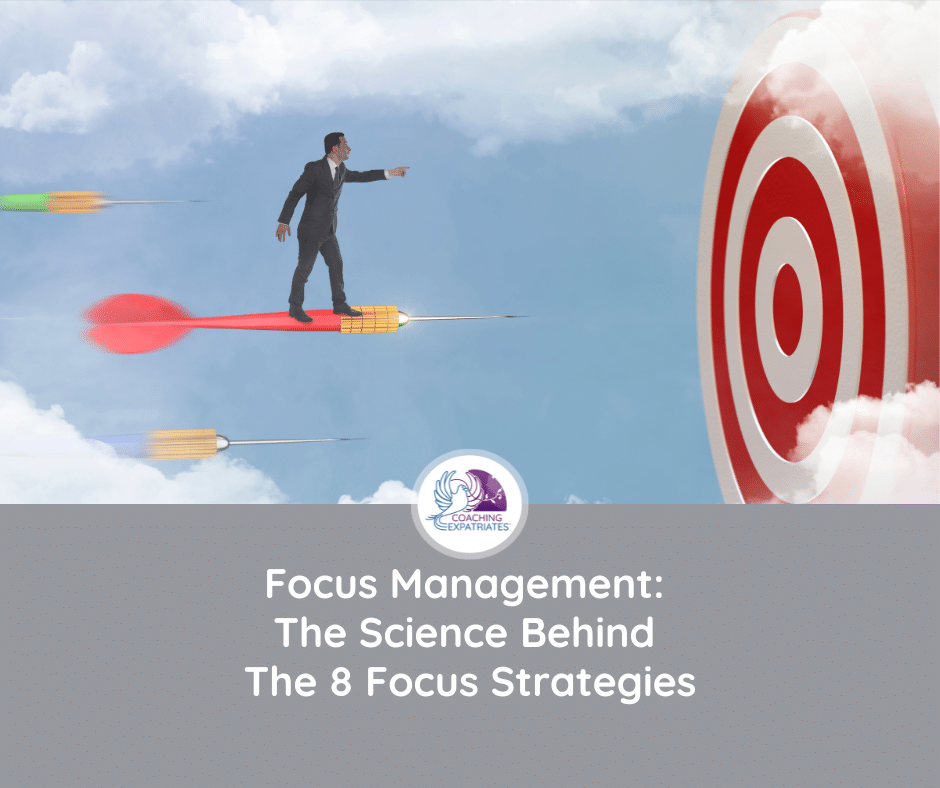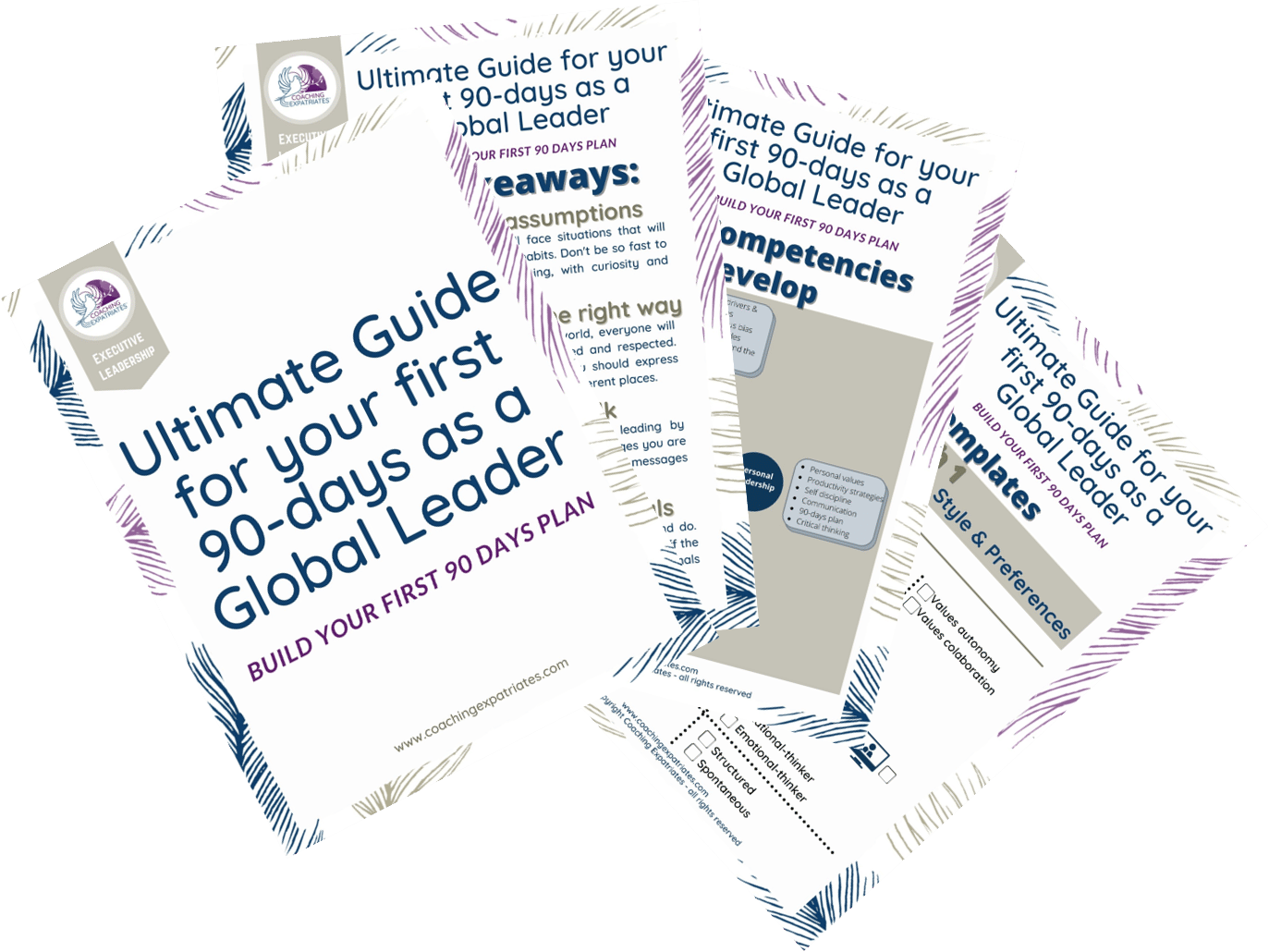Disclaimer: This focus strategies guide is comprehensive and in-depth, packed with research-backed data and resources to support the claims and strategies outlined. While it could take about 30 to 40 minutes for the average reader to complete—it offers valuable insights and tools for those looking to improve their focus management. Take your time to explore it thoroughly!
Table of Contents
Imagine sitting in your corner office, the city skyline stretching out behind you, and your calendar packed with back-to-back meetings. You’re juggling strategic decisions, managing a high-performing team, and steering the company towards its quarterly goals. Yet, despite all the effort, you notice a troubling pattern: projects are lagging, emails are going unanswered, and your team seems scattered and overwhelmed. This scenario isn’t just a hypothetical—it’s a daily reality for many executives. But what if there was a way to harness the collective focus of your team and drive meaningful progress? Welcome to the essential skill of focus management.
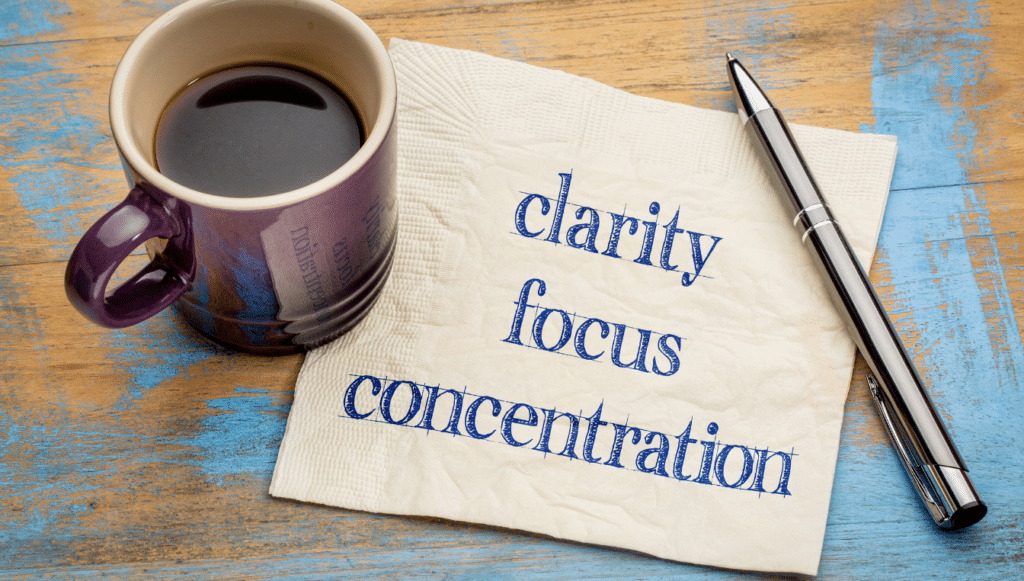
Defining Focus Management And Its Importance
Focus management is more than just a trendy term—it’s a crucial skill that transits between personal and people leadership within The Global Leadership Pillars® that impacts every facet of our lives and profession. At its core, focus management is the ability to direct your attention and energy during cognitive tasks toward the most important tasks, filtering out the noise and distractions that vie for your attention. It’s about being intentional with our time and mental resources.
For high executives, mastering focus management is key not only to personal productivity but also to effective leadership. It enables you to prioritize high-impact activities, make strategic decisions efficiently, and lead by example. Additionally, helping your team develop better focus can lead to improved collaboration, higher quality work, and the achievement of collective yearly goals.
The Challenges Of Maintaining Focus
In our hyper-connected world, maintaining focus is more challenging than ever. We’re constantly bombarded with notifications, emails, and a never-ending stream of information. Our brains are wired to react to these stimuli, making it difficult to concentrate on a single task for an extended period.
Moreover, the modern work environment often encourages multitasking, which studies have shown can reduce productivity and increase stress. The challenge, then, is not just about reducing distractions but also about developing habits and strategies that enhance our ability to stay focused amidst the chaos. For executives, this challenge extends to creating an environment where the entire team can thrive and maintain focus.
1 - Understanding Focus
Focus is often misunderstood, and many people struggle to grasp its true essence. It’s more than just the ability to concentrate on a task; it’s about directing your mental energy towards what’s most important. Let’s break down what focus really means, the types of focus strategies, and how they can be harnessed to drive both personal and professional success.
The Difference Between Focus And Attention
In the world of cognitive science—which delves into how we think, learn, and organize our minds—focus and attention are key concepts. This field pulls from psychology, linguistics, philosophy, and even computer science to understand how our brains work.
- Attention is our ability to process certain pieces of information while ignoring others. It’s about directing our mental resources to specific tasks or stimuli. Think of it as the broader capability to manage what we notice in our environment. For instance, when you’re at a concert, and a song triggers a memory from your childhood, you’re paying attention to both the music and the emotions it evokes.
- Focus, on the other hand, is a more specific subset of attention. It’s about zeroing in on a particular aspect or feature, requiring sustained mental effort. Focus involves filtering out irrelevant information and background noise to concentrate on what truly matters. For example, at that same concert, if you decide to concentrate solely on the guitar solo, ignoring the crowd and other distractions, you are focusing.
While attention gives us the ability to notice and switch between different stimuli, focus enables us to concentrate deeply on what’s most important, facilitating problem-solving and effective decision-making. While attention is a broader concept that encompasses various cognitive processes, focus is a more specific aspect of attention that involves directing attention to a particular aspect or feature of a stimulus.

The Concept Of Focus And Its Different Dimensions
Focus is a multifaceted concept that can be broken down into several dimensions. In this context, we’re not discussing business and marketing strategies like “differentiation focus strategy” or “cost focus strategy.” Instead, we’re focusing on human behavior and cognitive focus—how we direct our mental energy and attention.
Two key types of focus are attentional focus and cognitive focus:
- Attentional Focus refers to the ability to direct your attention to a specific stimulus while ignoring other stimuli. It’s like using a spotlight to illuminate one area on a stage, leaving everything else in the dark.
- Cognitive Focus involves using your mental resources to process specific information deeply. It’s more about how you think about and process the information you’re paying attention to, ensuring that you can understand, analyze, and use it effectively. Just like the spotlight analogy, cognitive focus is about understanding and interpreting what’s happening in that illuminated area on the stage.
While the focus discussed in human behavior and cognitive science revolves around directing mental attention and processing information, business and marketing focus strategies involve entirely different concepts. These strategies are about carving out a competitive position in the market and achieving long-term success by targeting specific market segments.
Business and Marketing Focus Strategies refer to methods companies use to dominate certain market niches, gain market shares, and build customer loyalty by concentrating on specific target markets. These strategies often involve identifying target audiences that align with the company’s strengths and competitive advantages. For instance, a company might choose to be a cost leader by offering lower prices in a narrow market segment, or it might differentiate itself by offering unique products that appeal to a particular market niche.
In business, helpful focus strategies might include:
- Market Niche: Specializing in a small segment of a broader core market, called “niche market segments” where the company can excel with deeper market penetration.
- Target Markets: Concentrating on specific customer groups that align with the company’s strengths and current market focus.
- Customer Loyalty: Building strong, lasting relationships with a focused group of customers.
- Industry Experience: Leveraging deep industry knowledge to serve specific markets better than competitors.
- Long-Term Success: Achieving sustained growth by dominating a particular market niche.
- Competitive Advantages: Developing unique strengths that give the company an edge in targeted segments.
By contrast, cognitive focus relates to how individuals can direct their attention and mental resources effectively to understand and act on information. While both concepts involve prioritization, one is about mental processes, and the other is about strategic positioning within a market.
In this article, our focus (pun intended) will be solely on the cognitive and human behavior aspects of focus management, exploring how individuals can harness their mental resources to achieve clarity, prioritize effectively, and maintain attention on what truly matters for a greater competitive edge.
The Science Behind Focus
In cognitive science, focus is about how the brain processes information and allocates attention. Our brains are constantly bombarded with sensory inputs, and it has to decide which ones to process deeply and which to ignore. This selection process happens in various brain regions, including the prefrontal cortex, which plays a crucial role in controlling our attention and focus.
When we focus, our brain increases neural activity in specific areas, allowing us to concentrate on tasks and filter out distractions. This involves a network of brain regions working together to prioritize important information over irrelevant stimuli.

Cognitive Control And Its Relation To Focus
Cognitive control is the ability to regulate thoughts and actions to achieve goals, and it’s closely related to focus. It helps us narrow our attention and plan our responses in advance.
Narrowing Attention: Cognitive control allows us to filter out distractions and concentrate on what matters most, enhancing our ability to focus on a single task.
Anticipatory Response Planning: It involves preparing and planning our responses to various situations, enabling us to stay focused and make better decisions even in complex environments.
Building Blocks Of Cognitive Control
Cognitive control comprises three essential components:
- Attention: The ability to concentrate on specific stimuli while ignoring others.
- Working Memory: Holding and manipulating information in your mind over short periods.
- Goal Management (Cognitive Flexibility): The ability to adapt your thinking and behavior to changing goals and environments. You might also see people referring to this ability as cognitive agility.
These building blocks work together to enhance focus, allowing us to stay on track and achieve our objectives efficiently.
Types Of Distractions
Daniel Goleman, in his book Focus: The Hidden Driver of Excellence, describes two main types of distractions:
- Sensory Distractions: These are external stimuli that interrupt our focus, like loud noises or visual clutter.
- Emotional Distractions: These are internal distractions, such as stress, anxiety, or even excitement, which can divert our attention from the task at hand. Emotional distractions can also impact our emotional regulation and, therefore, is a key management component for effective emotional regulation.
Cognitive control helps manage these distractions by filtering out irrelevant sensory inputs and regulating emotional responses, thus maintaining focus.
Personal Focus Management
Personal focus management involves using cognitive control to direct your attention and energy toward productive activities. It’s about setting priorities, managing distractions, and staying committed to your goals. Effective personal focus management means using your cognitive resources wisely to enhance productivity and achieve better outcomes.
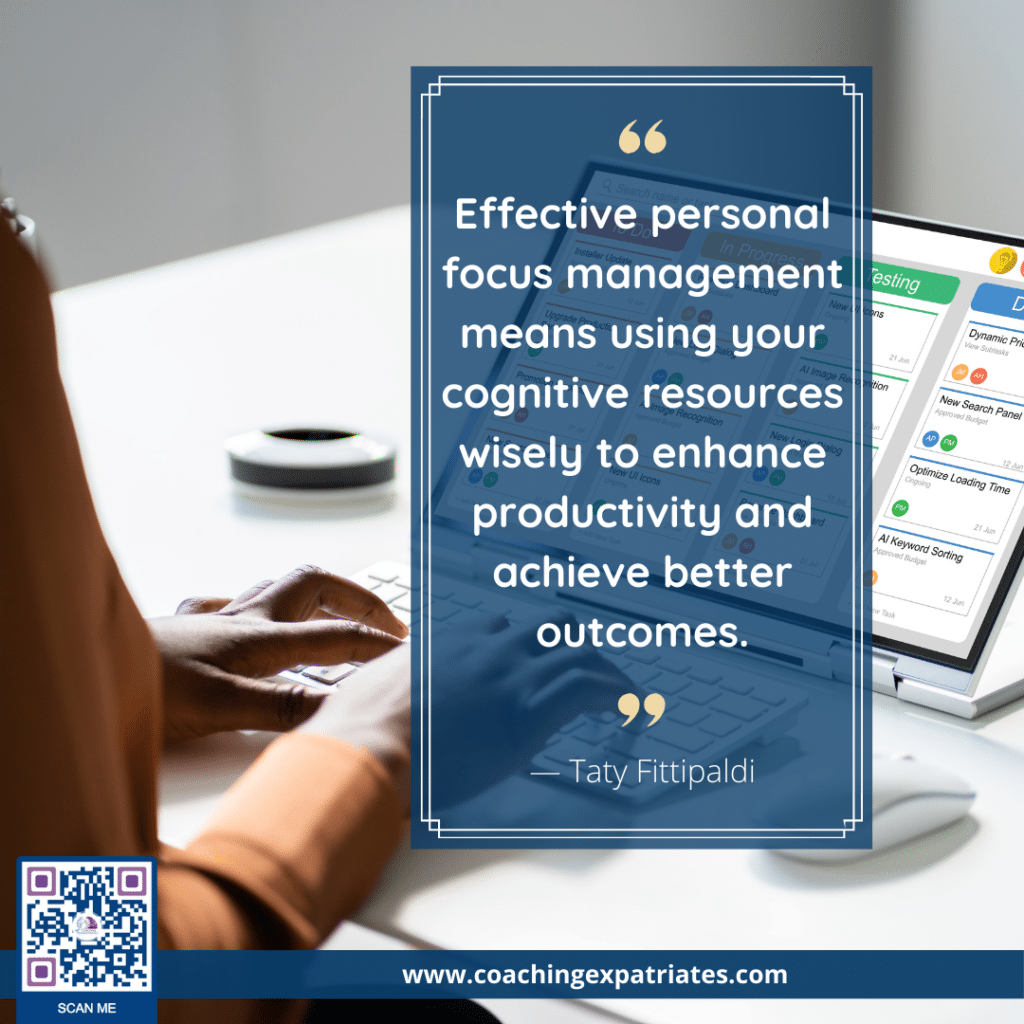
Team Focus Management In The Corporate World
For managers in the corporate world, team focus management is about creating an environment where everyone can concentrate on their tasks. This involves:
- Setting clear goals and expectations.
- Minimizing unnecessary distractions in the workplace.
- Encouraging regular breaks to prevent burnout.
- Promoting a culture of focus and productivity.
- Recommending and respecting the use of time-blocks.
By managing both personal and team focus effectively, executives can drive better performance and achieve their strategic objectives.
2 - The Corporate Impact Of Poor Focus Management
Poor focus management can have significant repercussions in a corporate setting, affecting both individual and team performance. Here are some of the key consequences:
- Decreased Productivity: When focus is fragmented, tasks take longer to complete, and the quality of work suffers. Employees may find themselves constantly switching between tasks, which reduces efficiency and increases the likelihood of errors.
- Increased Stress: A lack of focus often leads to missed deadlines and a backlog of unfinished tasks, creating a stressful work environment. This stress can further impede concentration and productivity, creating a vicious cycle.
- Impaired Decision-Making: Effective decision-making requires clear and focused thinking. When executives and their teams are distracted, they are more likely to make poor decisions, miss critical details, and overlook important opportunities.
- Errors and Omissions: Poor focus increases the risk of errors and omissions that can cost the company both money and reputation. These mistakes often require rework or damage control, leading to additional stress and further compounding the problem.
Statistics And Studies Illustrating The Effects Of Distraction
Numerous studies highlight the detrimental impact of distractions on corporate performance. Here are some compelling findings:
- Productivity Loss: According to research by Basex, interruptions cost U.S. businesses up to $588 billion per year in lost productivity. This figure includes periods of time spent recovering from interruptions and the reduction in work quality.
- Time Wasted: A study conducted by Gloria Mark at the University of California, Irvine, revealed that it takes an average of 23 minutes and 15 seconds to regain focus after an interruption. This means that even brief distractions can significantly derail productivity. (UC Irvine Bren ICS)
- Increased Error Rates: A study published in the Journal of Experimental Psychology found that people who are frequently interrupted experience a 20% increase in error rates. This is particularly concerning in high-stakes environments where accuracy is crucial.
- Stress Levels: The American Psychological Association (APA) has reported that workplace stress is a leading cause of employee dissatisfaction and turnover. Poor focus management, resulting from constant interruptions and multitasking, is a significant contributor to this stress.
These statistics underscore the critical importance of effective focus management in maintaining productivity, reducing stress, and enhancing decision-making in corporate environments.
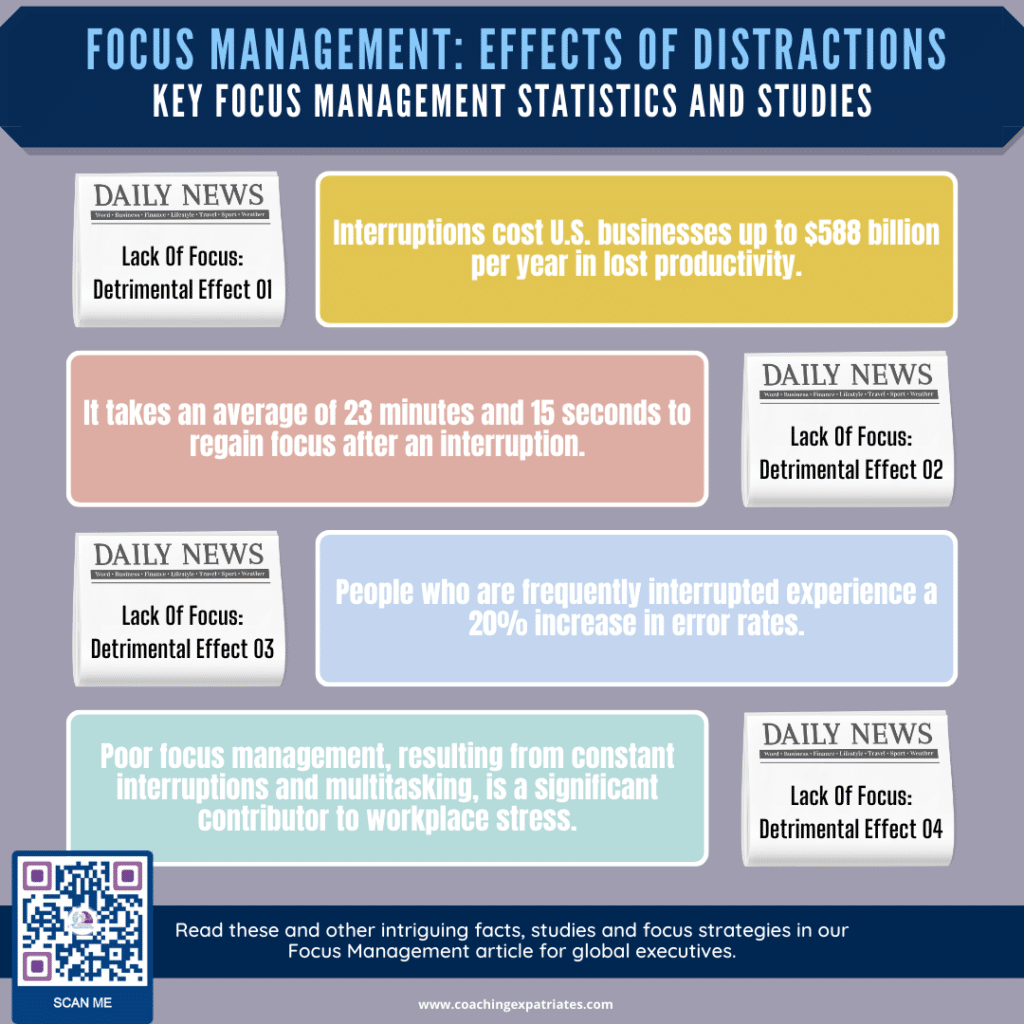
3 - Common Challenges To Focus
Who was never faced with a challenge that impacted their focus? Many of my clients report different challenges every single week. Several common challenges can undermine our focus and productivity. Here are some of the most prevalent:
- Multitasking: Often hailed as a productivity booster, research shows that multitasking can actually reduce efficiency and increase error rates. Switching between tasks takes time and disrupts the flow of work, leading to fragmented attention and reduced output quality.
- Technology Distractions: The constant barrage of emails, instant messages, and social media notifications can severely disrupt focus. Each interruption demands attention and can derail even the most focused individuals.
- Conflicts and Gossip: Workplace conflicts and gossip create a toxic environment that distracts employees from their tasks. Such issues can lead to a lack of concentration, increased stress, and lower morale.
- Job Uncertainty: Uncertainty about job security can cause significant stress, leading to distraction and decreased productivity. Employees preoccupied with concerns about their future are less likely to focus on their current tasks.
- Internal Distractions: Fatigue, stress, and emotional distress are major internal distractions. When employees are tired or emotionally troubled, their ability to concentrate on work diminishes, leading to lower productivity and increased error rates.
- Disorganized Leadership: Bosses who struggle to manage their own workload and are severely disorganized place a great toll on their teams. Their inability to manage and negotiate the demands and requests from various stakeholders, along with their failure to effectively project manage tasks, creates confusion and adds immense pressure on their employees. This chaotic environment undermines focus, increases stress, and significantly hampers overall productivity.
Spotting An Employee With Focus Management Issues
Identifying employees struggling with focus management is crucial for timely intervention. Here are some symptoms to watch for:
- Decreased Productivity: Struggling to complete tasks efficiently and effectively, often missing deadlines or producing subpar work.
- Increased Stress: Feeling overwhelmed and anxious due to a backlog of tasks and inability to prioritize effectively.
- Poor Decision-Making: Difficulty making decisions or making hasty, ill-informed choices due to a lack of clear focus and scattered thoughts.
- Reduced Quality of Work: Compromising on the quality of work, with more errors and less attention to detail.
- Constant Fatigue: Experiencing mental or physical exhaustion from trying to juggle too many tasks without clear focus.
- Forgetfulness: Missing meetings, deadlines, or failing to complete tasks because they slip one’s mind.
- Frustration and Irritability: Getting easily frustrated or annoyed with colleagues or work situations due to stress and lack of concentration.
- Difficulty in Task Transition: Finding it hard to switch between tasks, leading to procrastination or neglect of responsibilities.
- Lack of Engagement: Feeling disengaged or disinterested in tasks, which can affect motivation and overall job satisfaction.
- Dependency on Stimulants: Increasing reliance on caffeine or other stimulants to stay alert and maintain focus throughout the day.
- Impulse Purchases: Making unplanned purchases as a distraction or a quick way to feel good, often leading to regret and financial stress.
- Phone/Social Media Binging: Spending excessive time on phones or social media platforms, which disrupts productivity and focus, often at the cost of more meaningful or necessary tasks.
- Increased Absenteeism: Frequent absences or lateness.

I once managed an employee who, while not a top performer, was consistently reliable and steady in his work. He held a position where many stakeholders frequently made requests, and without a ticket system in place, he managed these demands with reasonable efficiency. His work ethics, performance, and habits were solid, if not remarkable.
However, seemingly out of nowhere, his behavior began to change drastically. He started arriving late, missing deadlines and meetings, ignoring requests, and even failing to show up for work at least once a week. These sudden shifts were alarming, and I quickly realized that his focus management had deteriorated significantly. It became clear that something deeper was affecting his ability to stay on track.
After some investigation, I discovered that he was struggling emotionally with the looming prospect of retirement, compounded by other issues at home. I provided constructive feedback, highlighting how his recent behavior was impacting his once-strong reputation. Together, we developed a plan that allowed him the space to address his personal challenges while also gradually regaining his focus on work.
With time and support, he made a career decision that brought him peace of mind, and his focus management issues dissipated almost immediately. His performance returned to its former steadiness, proving that with the right support and clarity, even significant disruptions to focus can be overcome.
Real-Life Challenge Examples That I Solved With Previous Clients
To illustrate these challenges, consider the following scenarios that some of my clients faced and that we had to solve together for greater productivity, confidence, and even team morale:
- Multitasking: Imagine an executive juggling multiple projects simultaneously. She spends her morning answering emails, attending meetings, and working on a presentation. By noon, she realizes she has made little progress on any single task, leading to frustration and a rushed, lower-quality presentation.
- Technology Distractions: A team leader constantly checks his phone during work hours, responding to every notification immediately. This habit leads to fragmented attention and a lack of deep work, resulting in missed project deadlines and frequent last-minute scrambles.
- Conflicts and Gossip: A department rife with gossip and interpersonal conflicts sees a significant drop in productivity. Employees spend more time discussing the latest office drama than focusing on their work, leading to missed deadlines and low team morale.
- Job Uncertainty: During a company-wide restructuring, employees are uncertain about their job security. One employee, in particular, spends more time worrying about potential layoffs than on his projects, resulting in decreased performance and increased errors.
- Internal Distractions: An employee going through a personal crisis struggles to maintain focus at work. She frequently misses deadlines and makes mistakes, further exacerbating her stress and creating a cycle of decreased productivity.
- Disorganized Leadership: An employee working at one of the world’s largest computer manufacturing companies faced immense pressure due to a disorganized boss who was incapable of saying no to stakeholders and managing their demands. Already a workaholic and perfectionist, this employee found himself overwhelmed by unrealistic expectations. Together, we worked to improve processes, reduce internal stress, and manage his workload more effectively, compensating for the leadership focus shortcomings that were exacerbating the situation.
These real-life examples from clients who looked for executive coaching to help them manage their situations highlight the importance of addressing focus management challenges to maintain a productive and positive work environment.
4 - Strategies For Improving Focus
Enhancing focus in a corporate setting requires a combination of strategies that address time management, mental well-being, work environment, and cognitive abilities. The true advantage of a successful focus strategy lies in an executive’s ability to harness their mental resources to achieve clarity, prioritize effectively, and maintain attention on what truly matters. By mastering this for both individual and team approach, leaders not only cultivate confident and focused employees but also drive the success of their company. The advantages of having a focus strategy extend beyond individual performance — it fosters a culture of precision and purpose, leading to sustained organizational growth and achievement.
Here are several techniques and core strategies that go beyond the generic strategy to help you and your team improve focus and productivity.
8 Proven Focus Management Strategies
Here are the 6 time-tested strategies, plus two bonus strategies featuring brain exercises and implementation tips, that key focus management professionals swear by to maintain peak performance and productivity:
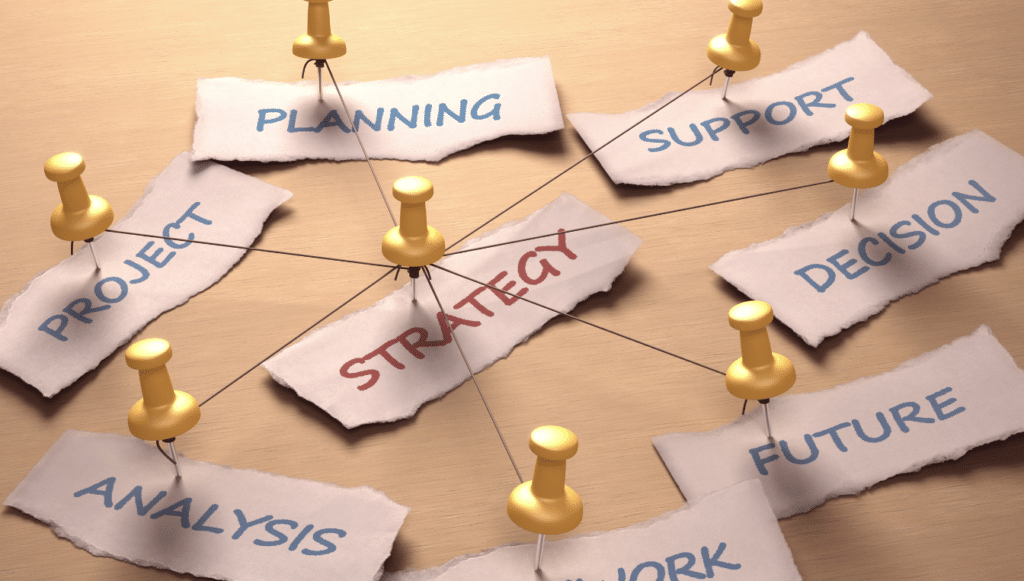
🎯STRATEGY 1: Time Management Techniques
Pomodoro Technique: This method involves laser-focusing on one work or task in 25-minute intervals followed by a 5-minute break. After four intervals, take a longer break of 15-30 minutes. This technique helps maintain high levels of focus while preventing burnout. Experiment with the time frame interval. For example, 25-minute intervals don’t work for me, as I usually need longer intervals, like 60-minute or 90-minute intervals, depending on what I’m working on. Test different intervals and see what works best for you.
Time Blocking: My all-favorite technique, allocate specific blocks of time for different tasks throughout the day. This helps create a structured schedule and reduces the temptation to multitask or manifest decision-fatigue in deciding what to do next.
Implementation Tips:
- Encourage team members to set timers during work intervals. This will also help them learn about their own working habits and intervals.
- Use shared calendars to block out focus periods and minimize interruptions.
- Establish team calendars to track important dates, vacations, and group tasks, ensuring that everyone stays aligned and informed about ongoing activities.
- Define team prioritization rules, like the Eisenhower Matrix or other types of prioritization methodologies, to focus on what matters.
If you want to learn more about this strategy for your personal context, consider taking our free High-Performance Workshop.
🎯STRATEGY 2: Mindfulness And Meditation Practices
Mindfulness and meditation can significantly improve focus by training the brain to stay present and focused. Regular practice can reduce stress, enhance emotional regulation, and improve concentration. For example, I started Transcendental Meditation when I was 14 years old and saw a huge spike in attention and focus that highly impacted my school scores. The reality is that focus is like a muscle: the more you use it, the better it becomes.
Implementation Tips:
- Start meetings with a brief mindfulness exercise if the corporate culture permits. One that I love is called “The Brain Scan.” It consists of asking the meeting team members to scan their brains for their worries and preoccupations of the moment, write them down on a paper, and tell their brains that now it’s time to focus on the topic of the meeting, and you’ll go back to what you wrote on the paper later on.
- Offer meditation sessions or apps like Headspace or Calm as part of employee wellness programs.
- Offer well-being and executive coaching for employees who need a more structured and methodical approach and powerful tools for mindfulness, awareness raising, clarity, and focus.
🎯STRATEGY 3: Creating An Optimal Work Environment
Minimizing Distractions: Create a workspace that reduces visual and auditory distractions. Use noise-canceling headphones, and keep the workspace tidy. The idea is to reduce sensory distractions.
Ergonomic Setup: Ensure that desks, chairs, and computer setups are ergonomically friendly to reduce physical strain and discomfort, which are also sensory distractions.
Implementation Tips:
- As a rule, designate quiet areas or focus rooms in the office where people are forbidden to approach you while you are there. These places are called “safe pods” and are designated places for focus, meditation, or calm time in the office.
- Provide ergonomic furniture and accessories.
- Create coordinated days for home office work when increased focus with fewer coworker interruptions is needed, as well as office days for total teamwork and collaboration.
🎯STRATEGY 4: Prioritization And Goal-Setting Methods
Eisenhower Matrix: Use this tool to categorize tasks into four quadrants based on urgency and importance. Focus on tasks that are both urgent and important.
SMART Goals: Set Specific, Measurable, Achievable, Relevant, and Time-bound goals to provide clear direction and motivation.
Implementation Tips:
- Regularly review team goals and priorities.
- Use project management tools to track progress and deadlines. One of my favorites is ClickUp.
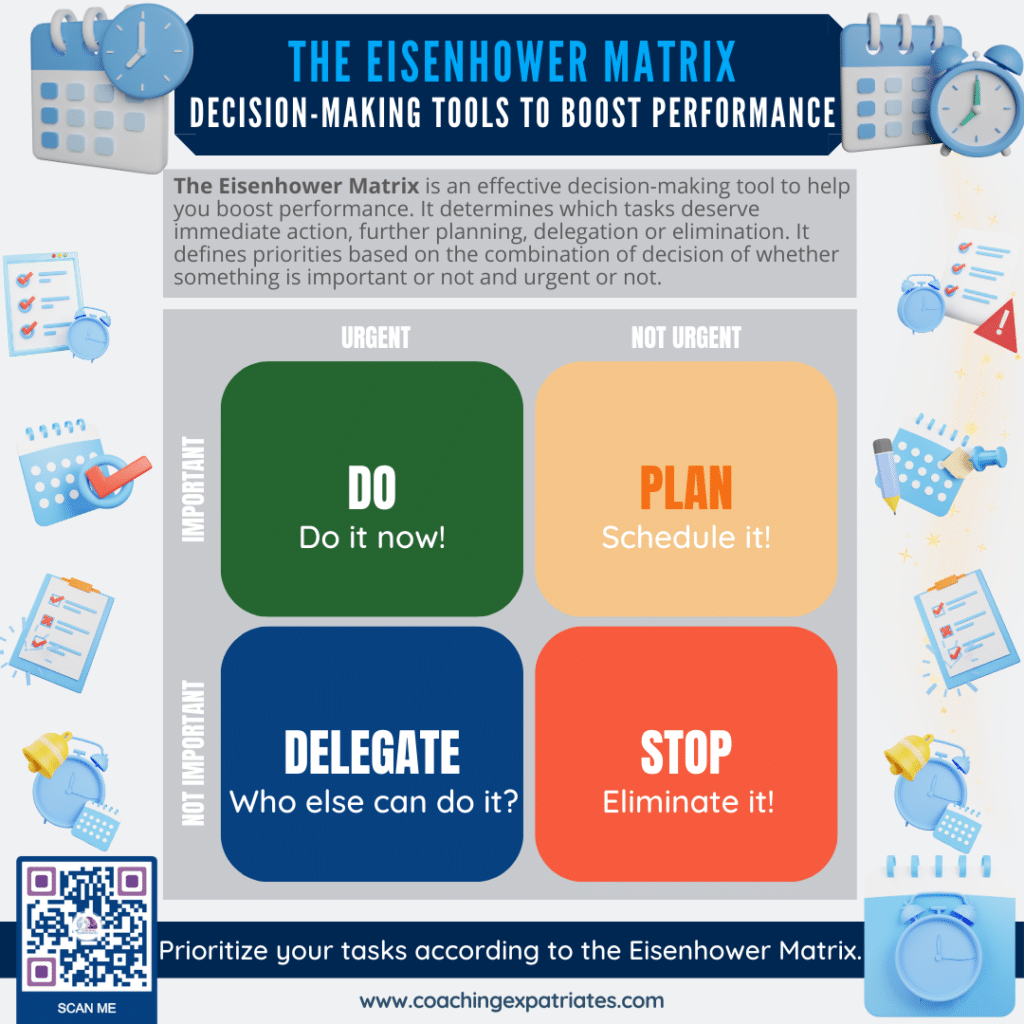
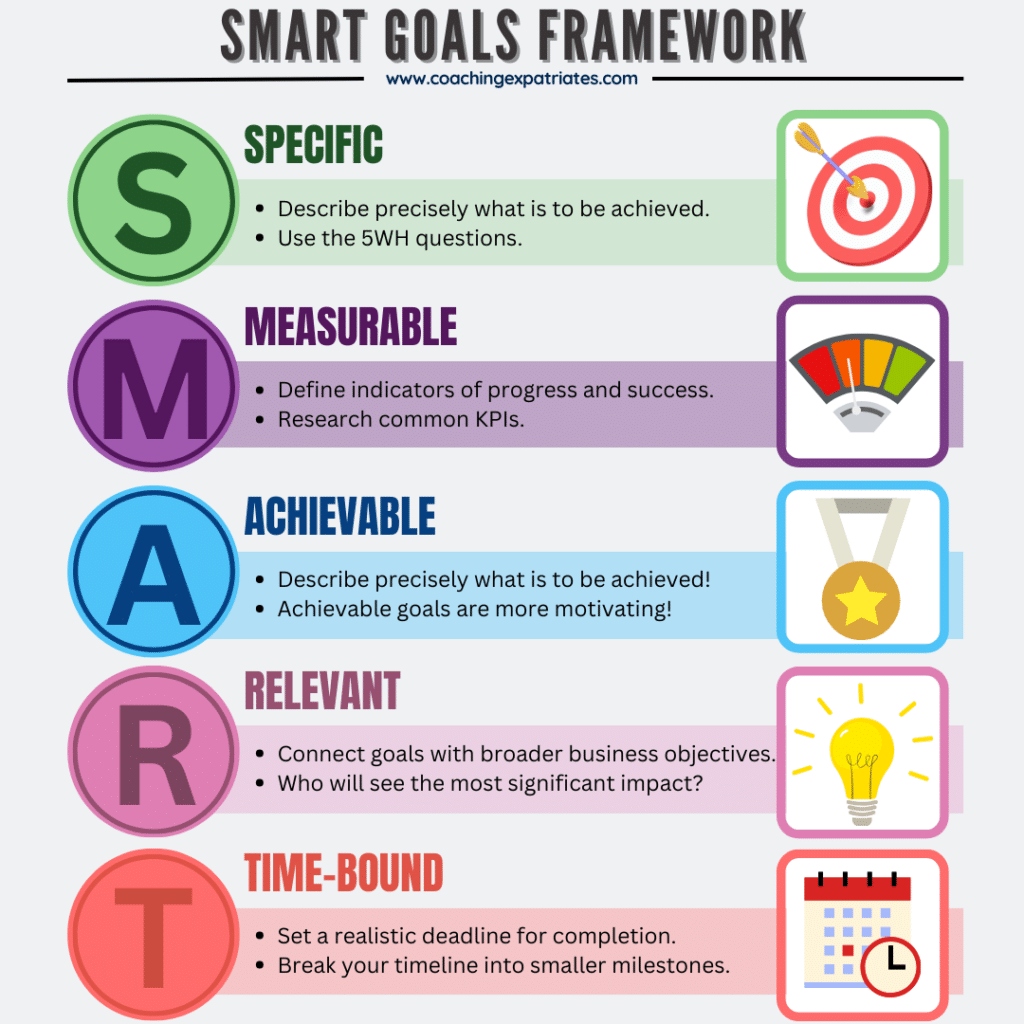
🎯STRATEGY 5: Methodical Breaks
Taking regular, methodical breaks is crucial for maintaining focus and preventing burnout. It’s counterintuitive to imagine that breaks improve focus, but research shows that a rested mind is more able to focus and process attention. Moreover, these studies show that breaks don’t need to be extended. Short breaks, such as a 2-minute break, according to Microsoft’s Human Factors Lab research, are already good enough to help the brain reset and refresh.
Encourage short breaks throughout the day and longer breaks during lunch. Some countries already do this as a cultural thing, like Brazilians who go out for lunch every day, while other cultures avoid this, like Americans who eat at their desks while still working. As a manager, it’s essential that you help your employees to self-regulate in terms of breaks and rests if they naturally don’t.
Implementation Tips:
- Schedule breaks into the workday.
- Promote physical activity during breaks, such as walking or stretching. For example, I once worked in an office where a physical therapist (PT) came to each floor every day for a 5-minute group stretch. It was super fun and helpful. Workers would create meetings and tasks around this event to make sure no one missed it.
- Set ‘break alarms’ on your phone and ensure they’re compatible with your focus time settings to remind you to take scheduled breaks without disrupting your workflow.
🎯STRATEGY 6: Sleep Well And Rest
Quality sleep is essential for cognitive function and focus. According to the Sleep Foundation, among other things, lack of sleep can lead to reduced attention spans and impaired judgment, which can impact focus. Encourage healthy sleep habits among employees by educating them about the importance of sleep and how to achieve it.
Implementation Tips:
- Share resources on good sleep hygiene and its importance.
- Avoid scheduling late-night or early-morning meetings, particularly for global companies with a worldwide presence. If you need to make a critical announcement across different time zones, like the US and Japan, consider making two separate announcements. Schedule one at the end of office hours and the other at the beginning. This approach minimizes gossip and noise while ensuring that everyone receives the information during their regular working hours.
🎯STRATEGY 7: Cognitive Strategies For Improving Attention And Concentration
Problem-Solving Exercises: Engage in activities that require strategic thinking and problem-solving to enhance cognitive flexibility.
Focus-Targeted Video Games: Certain video games can improve attention and concentration skills, as they work like a focus meditation.
Crosswords, Sudoku, Focus Puzzles: These activities stimulate the brain and improve cognitive abilities.
Implementation Tips:
🎯STRATEGY 8: Focus Redirection Or Refocus
Focus Redirection: Redirect focus whenever the attention to the matter at hand is lost. Refocusing involves the focus manager or focus agent noticing when they or their group have lost focus on the main task or priority and redirecting everyone’s attention back to what matters. This requires attentive listening, self-awareness, gaining clarity, and effective communication.
Implementation Tips:
- Attentive Listening: Pay close attention to signs of distraction or off-topic discussions. This awareness is the first step in recognizing when the focus needs to be redirected.
- Self-Awareness: Regularly check in with yourself and your team to assess whether everyone is staying on task. Encourage a culture of self-assessment.
- Clear Communication: Develop and practice clear, concise ways to redirect focus during your communication. Phrases like “Let’s get back on track” or “Our main priority right now is…” or “Now is not the time for this; now it’s time for…” can be effective.
- Regular Check-Ins: Schedule brief check-ins during meetings or work sessions to realign focus and ensure that everyone is on the same page.
- Visual Reminders: Use visual aids such as whiteboards, task lists, or digital project management tools to keep the main goals visible and top of mind.
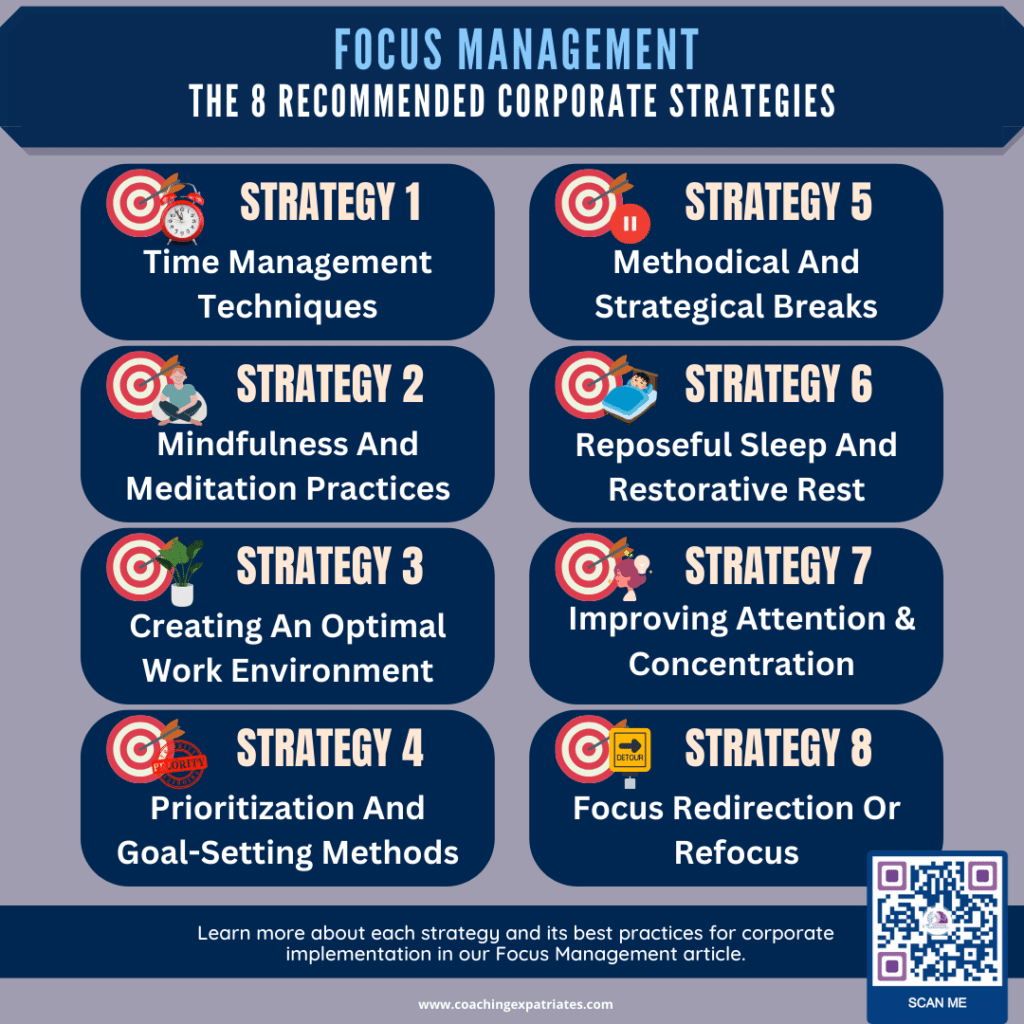
Team Focus Management Business Strategies: Lessons From SWAT
In the TV series “SWAT,” Hondo — the main character — often demonstrates effective focus management techniques during crisis moments. For instance, in Season 7, Episode 12 (“Allegiance”), Hondo redirects his team’s focus during a high-stakes situation involving the abduction of a teenager by eco-terrorists. Despite personal and team conflicts, Hondo emphasizes the importance of staying focused on the mission, showcasing how crucial it is to set aside personal issues and concentrate on the task at hand. This is one of my favorite focus strategy examples.

Pointers For Corporate Leaders:
- Stay Mission-Focused: Like Hondo, remind your team of the primary objective during crises. Encourage setting aside personal issues temporarily to achieve critical goals. You can stay mission-focused by saying, “We can focus on this later; now our priority is…”
- Effective Communication: Clearly communicate priorities and tasks, ensuring everyone understands their role and the importance of focusing on the task at hand. You can remind priorities by saying things like, “I know how important this topic is for you, but our priority right now is…”
- Support and Reassure: Provide support and reassurance to your team, especially during stressful times, to help them stay focused and motivated. You can acknowledge the stress and still show support by saying things like, “I know this is a stressful time for all of us. If you have an immediate concern or need support, please know my doors are always open for you, and I mean it.”
- Encourage a Positive Environment: Promote a culture where team members can address personal issues after the immediate crisis, fostering both empathy and professionalism. You can do this by saying things like, “I know this announcement can be unsettling, so avoid the temptation of engaging in gossip. If you want to bounce back ideas or process this situation in private with me, let me know. Let’s stay focused on our tasks.”
🎯BONUS STRATEGY: Using Business Storytelling For Greater Focus
When all else fails, there’s one powerful strategy that can cut through distractions, engage the mind, and refocus attention like nothing else — business storytelling.
Research has shown that storytelling has the unique ability to sync the minds of both the storyteller and the listener, creating a shared mental experience that enhances understanding and engagement. It also improves recall, making key messages more memorable, while triggering emotional connections that influence decisions and drive action.
Think about it: when was the last time a spreadsheet truly captivated an audience? Now compare that to a well-told story that framed the same data in a way that sparked curiosity, emotion, and clarity. The difference is night and day.
Business storytelling allows leaders to shift focus from something unwanted to something wanted, framing ideas in a way that is not just logical, but deeply engaging, emotional, and action-driven. It helps teams move from resistance to alignment, from uncertainty to clarity, and from inaction to execution.
How Business Storytelling Enhances Focus Management:
- Captures Attention Instantly: Storytelling activates the brain in ways that raw data or bullet points cannot. A well-constructed business story immediately draws people in and makes them want to pay attention.
- Creates Emotional Buy-in: Facts inform, but emotions drive action. When people feel connected to a story, they become invested in the outcome, naturally aligning their focus with the desired goal.
- Boosts Memory & Recall: Studies show that people remember stories far more than statistics. By framing important concepts within a story, executives can help teams retain and recall key priorities.
- Directs Focus Towards Solutions: Stories can subtly shift attention from problems to solutions, helping teams see opportunities rather than obstacles.
Implementation tips:
Start with an Easy Storytelling Framework: Don’t overcomplicate it — begin with a simple structure like The Challenge, The Journey, and The Outcome. Identify a problem, illustrate how it was tackled, and share the results. This makes storytelling feel natural and relatable.
Catalog and Index Your Stories: Start collecting and documenting stories from your own experiences, case studies, or industry insights. Index them by theme — leadership, resilience, decision-making, innovation — so that you can easily retrieve the right story when you need it.
Use Stories to Reframe Narratives: When teams or individuals are stuck in a negative mindset, replace discouraging narratives with empowering ones. Instead of focusing on what’s going wrong, share a story that highlights overcoming adversity or finding a breakthrough solution.
Engage, Don’t Discourage: Facts alone can feel dry or even demotivating, especially when discussing setbacks. Instead of saying, “We missed our target this quarter,” shift the focus with a story that inspires learning, resilience, and forward momentum.
Recognize Opportunities to Re-Focus Through Storytelling: Whether in a meeting that’s losing direction or in a one-on-one where an employee is disengaged, storytelling can redirect attention to what matters. Use it strategically in moments where focus needs realignment.
Shifting Focus with Storytelling in Action
Let’s say a team is fixated on an ongoing issue — perhaps a drop in sales or a failed initiative. A leader could approach this with raw data and logic, trying to convince them to pivot. But a well-crafted story about a competitor who turned a similar setback into a groundbreaking success will naturally shift the team’s focus to the possibility of innovation rather than failure.
This is the power of storytelling — it doesn’t force focus; it guides it effortlessly.
Want to Master Business Storytelling?
If you want to harness the power of storytelling to improve focus, productivity, and engagement, my book Mastering Business Storytelling is the ultimate guide. It provides practical techniques to craft compelling business narratives that influence, align, and drive action.
📖 Check it out and start using storytelling to refocus and lead with impact.
5 - Incorporating Technology In Focus Management
Technology has a significant impact on focus management, acting as both a hindrance and an aid. On one hand, constant notifications, social media, and the allure of the internet can fragment attention and reduce productivity. On the other hand, numerous tools and apps are designed to help manage time, minimize distractions, and enhance focus.
Productivity Tools And Apps For Staying Focused
There are several productivity tools and apps available that can help users stay focused and minimize distractions:
- Focus@Will: This app uses scientifically optimized music to improve concentration. It offers different types of music that can help maintain focus during work sessions.
- Forest: A unique app that encourages users to stay off their phones by growing virtual trees. If the user leaves the app to check social media or respond to non-urgent messages, the tree dies.
- Forest on iOS
- Forest on Android
- RescueTime: This app tracks the amount of time spent on different applications and websites, providing insights and reports to help use understand their habits and make adjustments.
- ClickUp: A project management tool that helps teams visually organize goals, priorities, tasks, and projects. It uses lists, boards, and other customizable views to streamline workflow and improve focus. It integrates with other productivity tools to enhance workflow.
- StayFocusd: A browser extension that restricts the amount of time spent on distracting websites. Users can set time limits for specific sites to enhance productivity.
- StayFocusd
- Focus Time: Most smartphones nowadays offer a routine for focused time. For example, I have a widget button on my home screen that starts my focus time routine. It’s customized to silence the phone except for customized contacts and situations. Whenever I am entering a client meeting or starting a task that requires focus, I just press my focus time to help me focus.
Using Technology Mindfully
While technology offers tools to aid focus, it is essential to use these tools mindfully and set boundaries to prevent overuse. Here are some tips:
- Set Specific Goals: Clearly define what you want to achieve using a particular app or tool. This helps in using technology purposefully rather than aimlessly.
- Limit Notifications: Turn off non-essential notifications to minimize interruptions during focused work periods. For example, I limit my phone notifications to credit cards, banks, and client requests during the Work routine. If it’s not a fraud alert or a client request, I must keep focus on whatever I am working on. All other notifications are a selective decision to look into or not during work hours.
- Create Tech-Free Zones: Designate certain areas or times of the day where technology use is limited or prohibited to encourage unplugged, focused work or rest.
- Use Time-Tracking Tools: Utilize apps like RescueTime to monitor and evaluate how much time is spent on different activities, helping to identify areas where technology use can be optimized.
- Regular Digital Detox: Schedule regular breaks from all digital devices to reset and recharge, preventing burnout and maintaining a healthy balance.
By incorporating these strategies and utilizing productivity tools mindfully, technology can become a powerful ally in managing focus and enhancing productivity.

6 - Overcoming Common Obstacles
When it comes to enhancing focus, many people encounter similar obstacles. Some of the most common challenges include procrastination, lack of motivation, and dealing with distractions. Understanding these barriers and finding ways to overcome them is crucial for improving focus and productivity.
- Procrastination: Procrastination is a major hurdle that prevents individuals from focusing on their tasks. It often stems from a fear of failure, feeling overwhelmed by the complexity of a task, or simply not knowing where to start.
- Lack of Motivation: Motivation can wane for various reasons, such as a lack of interest in the task, feeling disconnected from the end goal, or experiencing burnout. If this is happening to you, consider finding your Ikigai back.
- Distractions: External distractions (like noise, notifications, and interruptions) and internal distractions (such as stress, fatigue, or emotional distress) can severely impact one’s ability to focus.
Practical Advice And Encouragement For Overcoming These Obstacles
1. Tackling Procrastination
- Break Tasks into Smaller Steps: Divide larger tasks into more manageable sub-tasks. This approach makes the overall project seem less daunting and provides a clear roadmap for progress.
- Set Specific Deadlines: Establish clear deadlines for each sub-task to create a sense of urgency and commitment.
- Use the Two-Minute Rule: If a task can be completed in two minutes or less, do it immediately. This helps to reduce the buildup of small tasks and keeps momentum going.
2. Boosting Motivation
- Connect Tasks to Larger Goals: Relate daily tasks to your bigger objectives or personal values. Understanding how your work contributes to your overall goals can reignite motivation.
- Reward Yourself: Implement a reward system for completing tasks. This can be something small, like a coffee break, or larger, like treating yourself to something special after a major milestone.
- Stay Positive: Maintain a positive mindset by focusing on what you’ve accomplished rather than what’s left to do. Celebrate small wins to keep spirits high.
3. Managing Distractions
- Create a Distraction-Free Environment: Designate a specific area for focused work. Use tools like noise-canceling headphones and apps that block distracting websites.
- Set Boundaries: Let colleagues and family know your focus hours to minimize interruptions. Schedule specific times for checking emails and messages.
- Practice Mindfulness: Engage in mindfulness exercises to train your brain to stay present. This can help reduce internal distractions and improve concentration.
Improving focus is a journey that requires patience and persistence. It’s important to acknowledge progress, no matter how small, and understand that setbacks are a natural part of the process. Stay committed to your strategies, and gradually, you will see improvement in your ability to concentrate and achieve your goals.
7 - Case Study: The Power Of Clarity In Focus Management
In my recent article, “The 5 Powers of Clarity,” I discussed the essential role that clarity plays in making good decisions and achieving our goals. Without clarity, focus is nearly impossible, as clarity is a fundamental component of effective focus management. One example that illustrates this concept is a case involving a client who had recently been promoted to a managerial position for the first time and found herself struggling to focus.
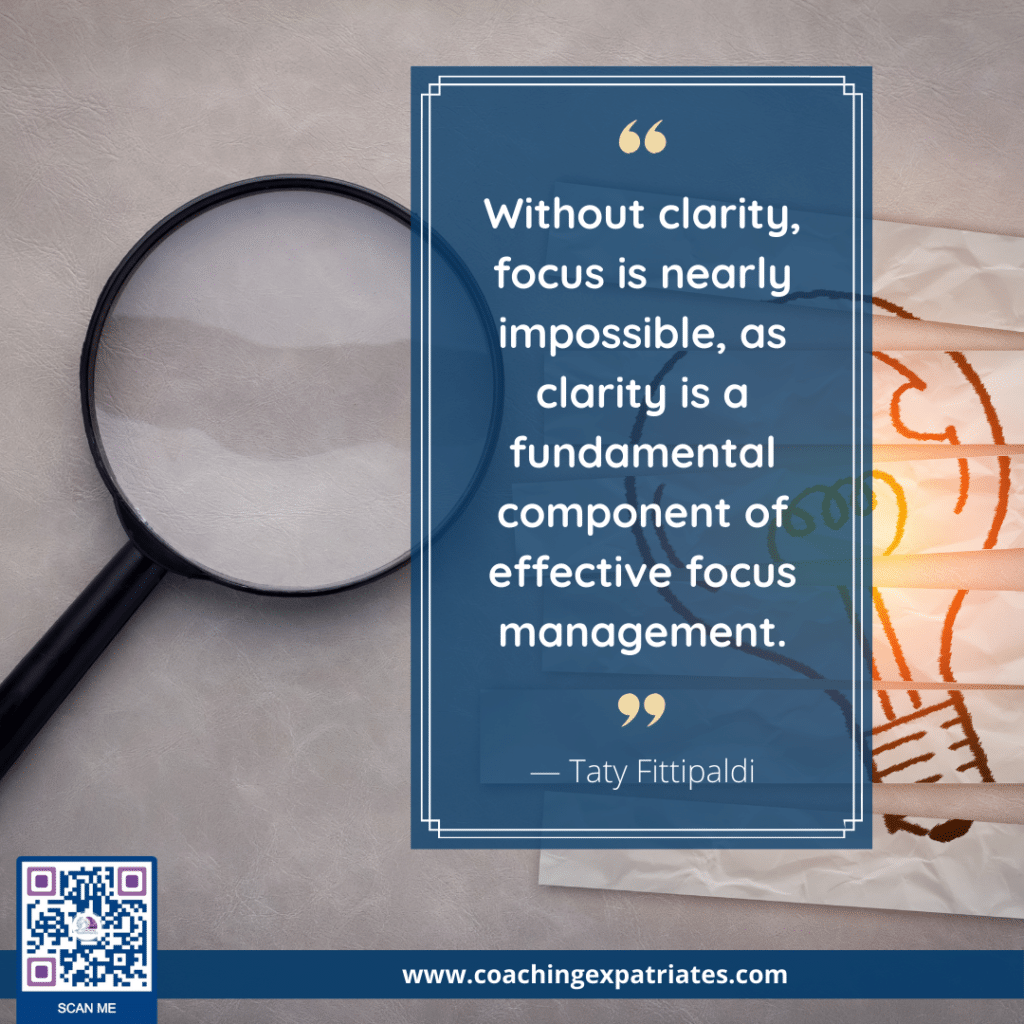
The Situation: The client was overwhelmed with her new responsibilities and activities, unable to concentrate on her tasks. This lack of focus was impacting her performance and her confidence in her new role.
The Approach: To address this, we started by clarifying several key aspects:
- Stakeholder Expectations: Understanding what her stakeholders expected from her in her new role.
- Goals: Defining what her goals were both personally and professionally.
- Reputation: Identifying what she wanted to be known for within the organization. I call this “defining your high reputation.” Gaining reputation is not something that happens to you; it’s something you build.
- Decision Criteria: Establishing a decision criteria she would use to make tough decisions consistently.
With these elements clarified, we were able to create a structured schedule that prioritized the activities needed to meet her goals and stakeholder expectations. This clarity laid the foundation for her to develop a focused action plan.
The Execution: Once the plan and schedule were in place, the focus shifted to execution. Week by week, I guided her to concentrate on the priority tasks. Gradually, she became adept at planning and focusing on her own without my close intervention.
The Results: By practicing these interconnected skills—gaining clarity, planning & prioritizing, and focus management — she quickly outperformed all stakeholder expectations. This not only enhanced her performance but also significantly boosted her confidence in her managerial role.
Key Takeaways For Leaders:
- Clarify Goals and Expectations: Ensure that you and your team have a clear understanding of what needs to be achieved and why.
- Develop a Structured Plan: Create a plan that prioritizes critical tasks and aligns with overall goals and expectations.
- Consistent Execution: Focus on executing the plan consistently, making adjustments as needed based on feedback and results.
- Build and Reinforce Skills: Encourage the development of skills related to clarity, planning, and focus management to enhance overall performance and confidence.
By integrating clarity into focus management, leaders can help their teams navigate complex responsibilities and achieve outstanding results.
Additional Resources & Recommendations
Books On Focus Management
For executives looking to enhance their focus management, the following books provide valuable insights, practical strategies, and a deeper understanding of how to optimize mental performance and productivity.
*This article contains product affiliate links in the Book and Tools section. I may receive a commission if you make a purchase after clicking on one of these links at no additional cost to you. They sponsor our time in curating resources and creating and sharing valuable thought-leadership content at no cost to you.
Focus: The Hidden Driver of Excellence
By Daniel Goleman (2013)
Description: In this seminal work, Daniel Goleman explores the science behind focus and its critical role in achieving success. The book delves into different types of attention and provides practical advice on how to cultivate focus in both personal and professional settings. Executives will find this book particularly valuable for understanding how to harness the power of focus to drive excellence and productivity.
Deep Work: Rules for Focused Success in a Distracted World
By Cal Newport (2016)
Description: Cal Newport argues that the ability to perform deep work—focused, uninterrupted work on cognitively demanding tasks—is becoming increasingly rare yet highly valuable in today’s knowledge economy. This book offers practical strategies for minimizing distractions and maximizing productivity through deep work. Executives will benefit from Newport’s actionable advice on how to structure their work environment and schedules to support sustained concentration and high-quality output.
The ONE Thing: The Surprisingly Simple Truth Behind Extraordinary Results
By Gary Keller and Jay Papasan (2013)
Description: Gary Keller and Jay Papasan emphasize the importance of focusing on the most critical task—the ONE Thing—that will make everything else easier or unnecessary. The book provides a framework for identifying and prioritizing this key task and maintaining unwavering focus on it. Executives will appreciate the clear, straightforward approach to eliminating distractions and achieving extraordinary results by honing in on what truly matters.
Mastering Business Storytelling:
By Taty Fittipaldi (2025)
Description: In Mastering Business Storytelling, you’ll discover how to use storytelling as a powerful tool to drive focus, engagement, and action within your team. Backed by research, this book shows you how to craft compelling narratives that cut through distractions, align priorities, and shift attention toward what truly matters. Whether you’re leading meetings, managing change, or influencing key decisions, mastering storytelling will help you enhance clarity, boost productivity, and create a more engaged, high-performing team.
Tools For Improving Focus Management
1. The Thinking Egg
Description: The Thinking Egg is a mindfulness tool designed to help users slow down, focus, and reduce stress. Made from various natural materials like wood, brass, or stone, it serves as a tactile reminder to take a moment to breathe and center oneself.
How It Helps Executives:
- Promotes Mindfulness: By holding the Thinking Egg and using it as a focal point, executives can practice mindfulness, which has been shown to reduce stress and improve concentration.
- Encourages Breaks: The tactile nature of the Thinking Egg encourages users to take short, purposeful breaks, which can rejuvenate the mind and prevent burnout.
Application in Day-to-Day Life:
- Desk Companion: Keep the Thinking Egg on your desk and use it during short breaks or when you feel overwhelmed to recenter your focus.
- Mindfulness Routine: Incorporate it into a daily mindfulness or meditation routine to start the day with clarity and focus.
Link: The Thinking Egg on Amazon
2. Moloho Pomodoro Timer
Description: The Moloho Pomodoro Timer is a dedicated device that follows the Pomodoro Technique, a time management method that uses intervals of focused work followed by short breaks. This timer helps structure work sessions to enhance productivity and concentration.
How It Helps Executives:
- Structured Work Sessions: The Pomodoro Technique divides work into manageable chunks, making large tasks less daunting and improving overall productivity.
- Reduces Burnout: Regular breaks scheduled by the timer help prevent burnout and maintain high levels of focus throughout the day.
Application in Day-to-Day Life:
- Task Management: Use the timer to break down large projects into 25-minute focused work sessions, followed by 5-minute breaks. After four sessions, take a longer break.
- Meetings and Brainstorming: Apply the Pomodoro Technique during meetings or brainstorming sessions to ensure focused discussions and prevent meetings from dragging on.
Link: Moloho Pomodoro Timer on Amazon
3. Cold Turkey Blocker
Description: Cold Turkey Blocker is a software application that helps users block distracting websites and apps, allowing them to stay focused on their work. It offers customizable block lists and scheduling options to control digital distractions effectively.
How It Helps Executives:
- Eliminates Distractions: By blocking distracting websites and apps, Cold Turkey helps executives stay focused on important tasks without the temptation to procrastinate.
- Customizable Focus Sessions: Users can schedule specific times to block distractions, aligning with their peak productivity periods.
Application in Day-to-Day Life:
- Focused Work Periods: Schedule distraction-free periods during the day when you need to focus on deep work, such as strategic planning or project development.
- Meeting Preparation: Use Cold Turkey to block distractions while preparing for important meetings or presentations, ensuring thorough and undistracted preparation.
Link: Cold Turkey Blocker
These tools can significantly enhance focus management for executives by promoting mindfulness, structuring work sessions, and eliminating digital distractions, leading to improved productivity and overall effectiveness.
Final Remarks
In this article, we’ve explored various aspects of focus management, including the importance of clarity, the challenges and obstacles that can hinder focus, and practical strategies and tools to improve it. Here are the key takeaways:
- Understanding Focus: Effective focus management starts with understanding the different dimensions of focus and how our brains process information. Cognitive control plays a crucial role in narrowing attention and making anticipatory response plans.
- The Impact of Poor Focus Management: Poor focus management can lead to decreased productivity, increased stress, and impaired decision-making. Studies highlight the significant impact of distractions on performance, emphasizing the need for effective focus strategies.
- Common Challenges to Focus: Procrastination, lack of motivation, and distractions are common obstacles. Recognizing these challenges and implementing practical solutions can help overcome them.
- Strategies for Improving Focus: Techniques such as the Pomodoro Technique, mindfulness practices, creating an optimal work environment, and cognitive training exercises are valuable tools for enhancing focus.
- Incorporating Technology: While technology can be a source of distraction, it can also aid focus management through productivity tools like Focus@Will, Forest, RescueTime, ClickUp, StayFocusd, and Todoist.
- Case Study: A real-life example illustrated how clarity in stakeholder expectations, goals, and decision criteria can significantly enhance focus management, leading to improved performance and confidence.
Experiment with different focus management strategies and tools to find what works best for you and your teams. Cultivating focus is a journey that offers long-term benefits for personal and professional success. Like any journey, you might need a guide.
If you’re looking to improve your focus management skills or enhance your team’s performance, consider hiring an executive coach. An executive coach can provide personalized guidance and support, helping you develop effective focus strategies tailored to your unique needs and goals. Consider hiring me as your executive coach for yourself or for your team members. Have a Free Strategy Call with me. We will go over your specific situation, and devise together a methodical but fun plan for focus management.
If you are interested in developing focus management and other specific global leadership skills, personally or team-wise, check out our paid online Global Executive Leadership program. We go over all The Global Leadership Pillars® during 9 online modules, specially meant for global leadership development. It’s a unique leadership training methodology that will change the way you think, relate, and strategize as a global leader.
You can also gain incredible insights by subscribing to our free global leadership podcast, The Leadership Nest.
If you enjoyed this post, consider subscribing to our weekly newsletter using the form below. We focus on providing good content to global leaders and executives who want to make impactful business decisions and be more inclusive and influential. We know your inbox is sacred, so we email just once per week, and we never sell, rent, or do anything funky with your information. Trust is the basis of Global Leadership, and we fully honor it.

